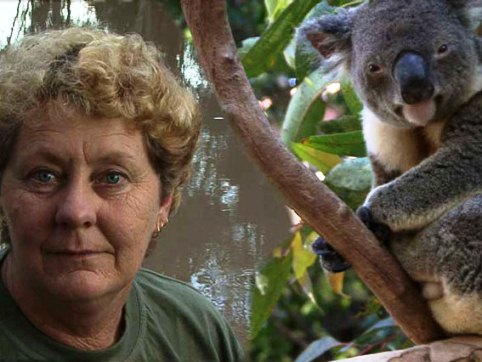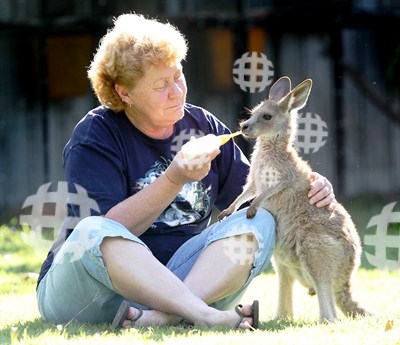Australia’s Koala ‘Mum’
 When we heard that one of the nominees for Australia’s prestigious Pride of Australia award this year was Ruth Lewis of the Ipswitch Koala Protection Society, we called her up to find out a little more about her work – not just with koalas but also kangaroos and all manner of wildlife. We reached her at the society’s clinic outside Brisbane, Queensland, at the end of feeding time on a Sunday morning.
When we heard that one of the nominees for Australia’s prestigious Pride of Australia award this year was Ruth Lewis of the Ipswitch Koala Protection Society, we called her up to find out a little more about her work – not just with koalas but also kangaroos and all manner of wildlife. We reached her at the society’s clinic outside Brisbane, Queensland, at the end of feeding time on a Sunday morning.
Zoe: How many koalas do you have at the moment?
Ruth Lewis: Here at our small clinic, 20 or 21. Then we bring them into the koala hospital, where they get assessed by a vet. Depending on what’s wrong, they’ll get a general anesthetic so that we can assess them while they’re asleep. Much nicer to work with a koala that’s asleep than one that wants to rip your arms and legs off!
Zoe: What kinds of health issues do they have?
Ruth: Chlamydia would be the largest. The biggest problem that koalas are facing is, of course, loss of habitat. And chlamydia, whether conjunctivitis or cystitis or pneumonia, is a stress-related disease.
Zoe: Do you deal with kangaroos as well?
Ruth: Mainly we look after and rescue wallabies and kangaroos and koalas, possums and gliders, flying foxes and birds. Lots of birds.
The koalas, I suppose, aren’t such a novelty to us, except that we’re trying to save what’s left of them. There’s not too many left because more and more people want to live here.
Zoe: When some of us see koalas on TV, we think of them as just being hugely cute, obviously. But …
Ruth: But they’re not. Well, they are. They’re hugely cute, but they can do some serious damage.
Zoe: What got you into this work in the first place?
Ruth: When I was little, my mom just about despaired because I was always coming home with an animal under my arm. Then I got married and had my own children. When they were up and off to school, I got involved in a wildlife rescue group. It just sort of grew from there.
Zoe: How many koalas do you bring in each week on average?
Ruth: We’ve rescued 14 koalas in the last week. Three of them had died already when I picked them up. But we bring them in anyway because we need to understand what happened to them. Three of the 14 are being treated for conjunctivitis. Two more were checked and microchipped and they were fine and I put them back in the wild. The others had to be euthanized with diseases that can’t be fixed.
Koalas are territorial; they have to go back where they came from. Our database has something like 40,000 koalas on it. Anything that comes back in, we can scan it, see if it’s got a microchip. We’ll know who it is, how old they were, where they’ve been. That tells us a lot.
Zoe: How are the koalas being affected by the drought?
Ruth: In the really bad drought parts of Queensland, there may not even be koalas there anymore. In the coastal areas, we’re seeing a lot of koalas coexisting with suburbia. The more houses, the more dogs and the more cars you’ve got, so they’re starting to disappear very rapidly.
Zoe: What kind of personalities do they have? Is it very different from the image we have of these super-cuddly, big eyes with their arms wrapped around you?
Ruth: Well, the babies do that. They all have different personalities. Some of them are just really dopey and quite happy to be part of. I wouldn’t pick them up and cuddle, but they’ll let you scratch their ears. Once they been in the hospital for a while, they get quite used to human interaction because we’re feeding them. The baby orphans are like human babies. They’re totally reliant on you for their milk. You’re just mom, and they just want to be on you the whole time. But the ones in the wild, they’ve got very sharp teeth and very big paws. They can do a lot of damage; I wouldn’t just go and pick one up in the wild, unless it’s really, really sick. If you can pick one up in the wild, it’s probably got some very serious problems.
 Zoe: What about the kangaroos?
Zoe: What about the kangaroos?
Ruth: We hand-raise the orphans, too. One very special baby I did a few years ago was a baby echidna and he just looked like a potato and we called him Hoover. Once you start to wean them and stop feeding them milk, they get a little bit bigger and you stop handling them and they go into a tree. It’s like a human kid.
Then we put them into koala [or kangaroo] kindergarten at the hospital, where they learn to interact with other koalas, although they’re solitary animals—they don’t live in mobs like the kangaroos do; they are very solitary. But they are going to come across other koalas from time to time and during breeding season.
Zoe: Do they have their own kind of language?
Ruth: They do. You can tell the different noises that they make. If the babies are calling, looking for mum, they’re not real happy because you’ve left them sitting in their cage or in their tree and they start calling out. Once they get bigger, then they start the grunting to say: “Well, here I am and this is my tree.” They start marking their territory.
It’s wonderful to have koalas wandering around the house. And they are all different. They’re all different, they just have so much, so many different personalities. Some of them like to sleep on the floor like a floor-mat and you’ve got to try and teach them that the tree is where they need to be. Up the tree.
Zoe: What do you want people to know about koalas and kangaroos and other wildlife?
Ruth: I tell them that if we don’t protect what we’ve got now, once koalas are gone from the wild, and any of the other animals, they’re gone from the whole world. They’re a national treasure and it won’t be just Australia that’s going to suffer. It’ll be the whole world.
